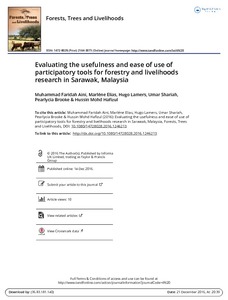Resource information
(http://creativecommons.org/licenses/by-nc-nd/4.0/), which permits non-commercial re-use, distribution, and reproduction in any medium,
provided the original work is properly cited, and is not altered, transformed, or built upon in any way.
Sarawak, Malaysia, is home to a wide range of native fruit tree species (NFTs) that contribute to the livelihoods of rural women and men. Yet, most agricultural research in the area, and elsewhere, has focused on commercial, non-native species, and the economic potential of lesser-known NFTs has often been overlooked. What is more, little attention has focused on research for development tools that can build on the local ecological knowledge of both men and women while supporting forest-based livelihoods and biodiversity conservation. This study contributes to filling this gap by assessing the usefulness and ease of use of a set of participatory tools – Four Cell Analysis, Venn Diagrams, Participatory Value Chain Mapping and Participatory Rapid Market Appraisal – that enable villagers to engage in a gender-responsive learning process supporting livelihood initiatives around native fruit trees. Activities, which focused on mango (Mangifera spp.) and rambutan (Nephelium spp.), were conducted in two villages in Sarawak. Research was carried out within gender and age specific groups, which then came together to share and discuss their findings. Participants evaluated the tools and approach based on their usefulness to the community and their ease of use. Key findings were that women’s and men’s different yet overlapping knowledge about forest resources was well captured using the four tools. Although each tool generated useful information, the combination of tools was important for painting a fuller picture of ecological, organizational, and marketing aspects related to native fruit trees and the sequence of activities supported local learning processes. Participants found the four tools moderately easy to easy to use, and the process of working within gender and age segregated groups and bringing the groups together promoted freedom of expression within groups as well as inter-group learning.



